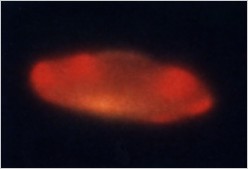 |  | 

By Rod Dickinson
Images of the otherworld and the supernatural are legion in art history. The secular 20th century has also produced an abundance of artists whose work draws upon occult ideas or the paranormal. 'The Inner Eye' a recent touring exhibition brought together some of these representations, alongside artifacts and photographs associated with a variety of spirit and paranormal phenomena. Both art works and fortean artifacts were presented without differentiation, as equally legitimate ways to approach or render the spiritual and the invisible. In this context the issue of whether the fortean artifacts on display were the result of otherworldly intervention, or as in the case of the spirit photographs, crude double exposures...became irrelevant.
Whilst this exhibition dealt with an essentially 19th century conception of other dimensions and realms, across the Atlantic the Huntington Beach Art Centre in California recently showed, 'Are We Touched? Identities from Outer Space' an exhibition assembled on a similar premise to 'The Inner Eye', an anthropological exploration of UFO culture bringing together contemporary art and UFO groups. Amongst the diverse participants were Heavens Gate, and drawings by Allagash abductee Chuck Rak.
Both these exhibitions traced that folkloric process, where real events are transformed into myth, and myths are made real - This process permeates many aspects of the fortean field via abundant visual representations. Surprisingly it is all but ignored by researchers. Yet much of the visual iconography of Ufology is composed of photographs and artifacts that owe more to creative acts of the imagination than evidence of alien intervention. From George Adamski and Daniel Fry to Billy Meier and Ed Walters. Latter contributors to the genre include Doug Bower (crop circles) and Ray Santilli and co (dead aliens).
Exhibitions like these allow this persistent and clandestine type of creative endeavour to be appraised alongside more conventional art works, and without resort to that reductive Ufological diagnosis of 'hoax or genuine'. The continuity, often over decades, of some of these scurrilous deeds perpetrated by individuals who invest a large amount of time and imagination, often with little to gain, apparently defies explanation - But considered as an elusive and esoteric branch of folk art it begins to make a lot more sense. Imagine Adamski, Walters et al with their homemade flying saucer models (one of Walter's was found in his house) with camera invisible strings, blackout curtains and double exposures. The very same technique mediums were using to produce spirit photographs at the beginning of the century. Both subjects additionally propelled by photography's ability to simultaneously connect and disconnect the viewer with reality (1).
The mandala like image of the flying disc (itself based on a misunderstanding of Kenneth Arnold's original sighting in 1947) has such a resonance in human culture that Carl Jung speculated its origins, despite being manifested psychically, probably lay within the imagination (2). The disc or circle is also the main component of the crop circle phenomenon, which also has it's committed practitioners, who account for the most spectacular designs that appear annually.  As one of their number I am aware that we also observe a rigid set of parameters and construction techniques ensuring the continuity of the phenomenon from year to year. As one of their number I am aware that we also observe a rigid set of parameters and construction techniques ensuring the continuity of the phenomenon from year to year.
Likewise it is possible to view the collective body of drawings made by abductees as a similar type of folk art, whatever the origin of their experiences.
Forays into other fortean areas have also been made by American artist Jeffrey Vallance, whose images of simulacra that occasionally appear in Fortean Times leave us unable to distinguish between artifice and reality, and Doc Shiels, whose sea monster photographs have much in common with the aforementioned UFO images. These art forms inspire a range of transfiguring interpretation and perception. Elevated from beyond their prosaic origins they are deposited in the realm of miracles, and otherworldly intervention.
This kind of artistic activity has also had a direct influence on conventional art practice - many of the surrealists and symbolist artists were influenced by 19th century occult doctrines and apparent paranormal phenomena; from C.W. Leadbeater's illustrations of 'thought forms' to the technique of automatic writing (3).
Whilst mostly outside the parameters of conventional art practice this type of folk art embraces that rich vein of mythology occupied by the trickster. Far from the cynic or the skeptic the trickster, from shamanic cultures to our own has punctuated history with lies and deceptions, The resulting collision of genuine and fake, artifice and reality has created a paradoxical twilight reality that is the arena of strange phenomena. Artists (in all but name) have found and populated this arena for decades, perhaps even centuries, regularly producing representations, which, at their best are visionary works of art.
1 Tom Gunning: Phantom Images and Modern Manifestations, in: Fugitive Images From photography to Video 1995, Indiana University Press
2 C.G.Jung : Flying Saucers A Modern Myth of Things Seen In The Sky
3 Examples of both Leadbeater's thought forms and automatic writing were included in 'The Inner Eye'
Photo: Taken at Chibolton Observatory on April 26th 1996 by Rod Dickinson
|  |  |













